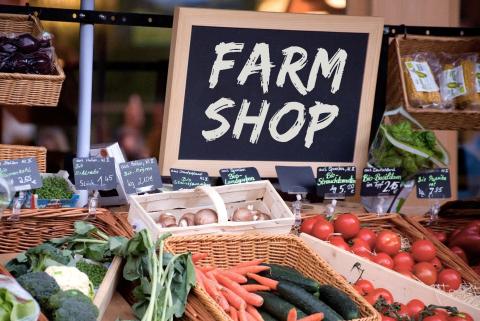19 May 2022
Dr David Cutress: IBERS, Aberystwyth University.
- Agricultural diversification is a complex situation to assess with different effects regionally and globally
- Diversification can play significant roles in the financial stability of farm businesses with larger farms able to leverage advantages often less accessible to smaller enterprises
- The encouragement of training and skill-building considerations for farmers as well as a focus on the right kind of incentive strategies could assist more farmers in diversifying
Diversification and definitions
Diversification within the agricultural sector is increasingly being discussed as a method for farm businesses to break even and make profits more consistently. Traditional farming strategies, particularly in small-medium enterprise farms (SMEs), which act as the core of most rural landscapes, struggle to achieve net profit gains without the addition of government subsidy schemes such as the basic payment scheme (BPS). Diversification is regularly highlighted as a method of capturing alternative lucrative financial gains. In 2012 it was noted that 50% of UK farms gained some form of income from non-farming diversification whilst in around 30% of these systems the diversified income actually exceeded the farm income. Through assessing diversification, from a research perspective we can gain data and insights that could help diversification practices to succeed. This can also help us to understand individuals who are currently opposed to diversification helping advisory systems and government incentive schemes to operate in a way that improves farmer uptake and focuses on their needs and desires.
A well-cited paper within the field of research defines farm diversification as “a strategically systemic planned movement away from core activities of the business, as a consequence of external pressures, in an effort to remain in and grow the business”. Research following this has noted overlaps of meaning from terms other than “diversification”, including pluriactivity, multifunctionality and entrepreneurship. Pluriactivity, refers to income-earning employment or practices outside of the farm to maintain the household’s stability, with surveys across Wales demonstrating that 41% of farm households were pluriactive in 2010. These facts do much to suggest that farming alone is often insufficient as the main revenue source, thus it is unsurprising that diversification is increasingly being considered. So, what are some other pressures and incentives for the diversification of farm portfolios? An evaluation of multiple papers highlights the following areas;
|
Pressure |
Incentive |
|
||
|
|
|
||
|
|
|
||
|
|
|||
|
|
|
||
|
|
|
||
|
|
|
||
|
|
|
||
Several of these impact farm businesses to different degrees in different locations or due to different situations. It is suggested, however, that pressures (or pushes) where diversification is essential for farm survival appear to be less effective at leading to entrepreneurial diversification compared to incentives (pulls). This advises that agricultural advisory boards and government agencies should focus on supplying incentives for diversification as much as possible.
Investigative insights
Diversification in research is often linked with discussions surrounding general entrepreneurial abilities/skills and natures of farmers and farm families in smaller enterprises. However, diversification is still a relatively neglected area of literature in general. Much of the internal training, strategic planning and formulation on family farms revolves around narrative and internal knowledge exchange within the family. Where family is concerned, the clustering of SMEs, inclusive of multiple farms, or farms with other small businesses, spreads the risk and essentially increases the overall size of the business. This is particularly discussed where smaller farm businesses of different relatives within the same family organise together as a common strategy. Vitally, agricultural SMEs are more likely to have a static mindset compared to larger agricultural enterprises, thinking of themselves as traditional producers/suppliers rather than innovators and leaders in their fields. Strategies such as coaching and mentoring have been shown to help those in SME businesses identify as leaders and find the right answers to suit them, through guidance rather than by being told exactly what they should be doing.
In response to this focus on diversification, leadership and innovation in agricultural systems there has been a clear switch in recent years towards incorporating diversification/entrepreneurial training for farmers and agricultural students in higher education. Suggesting it has been taken up as a core area for the success of the sector. This is likely a result of the vast area of research which highlights training and up-skilling the new generation of farmers is key for long term sustainable succession.
Innovation networks have also been noted to play roles in boosting and targeting diversification by taking into account ideas and resources available from universities, research centres, consultants, suppliers and customers. Innovations networks are thought to help smaller farm businesses specifically to overcome barriers with their lack of size and resources by connecting them with a network full of knowledge and resources. These have helped in improving both environmental farm performance and financial farm performance in European studies. These principles underpin the European Innovation Partnerships scheme which farmers and foresters in Wales have benefitted from through collaborating in innovative projects that have helped with the understanding of the impacts of different diversification opportunities.
Options for diversification
Diversification can be within the sector and outside of the agricultural sector. Opening new marketing routes for products or services being produced on-farm can lead to new revenue streams. Examples of within sector diversifications include;
- Alternative crops (inclusive of feed or food and medicinal)
- Alternative livestock or livestock management (dairy sheep, dairy goats in the UK)
- Alternative production strategies (regenerative, controlled environment, organic)
- Reducing the food chain (on-site abattoirs, processing units and farm shops, online direct sales)
- Alternative produce (Butter, cheese, ice cream, cider, wine, wool, hides)
- Contracting for other farmers
- Land leasing
Whilst external diversification routes have a wealth of options available including;
- Agritourism (Accommodation, activity holidays etc)
- Rentals
- Retail (Farm shops and other retail ventures)
- Training (Animal husbandry training, crop cultivation training, traditional skill training)
- Contracting (for non-farm based organisations/businesses)
- Alternative fuels and waste utilisation (biofuels, Anaerobic digester plants, composting plants)
- Renewable energy
Two of the most common routes of external diversification discussed throughout the literature are agritourism (which encompasses several different possible enterprises) and retail via farm shops as a direct sales route to customers. Whilst these have a lot of potentials they do not come without their complications and barriers. Both rely on the farms' location to a customer base with many rural areas lacking the necessary customers to make them financially viable. For agritourism, the presence of other activities in the surrounding area to further encourage customers to visit is also a consideration. Yet, agritourism has been documented to place pressures on farms to give a certain visual of farming to customers which is different to the traditional practices normally employed. Essentially this can lead to a ‘tourist farm’ and a ‘working farm’ behind the scenes which can add increased labour and is noted to impact many farmers' enjoyment of their farming practices.
Barriers to overcome
Diversification and entrepreneurial innovations are areas of possible economic improvement in agriculture, particularly for SMEs to compete with larger agricultural businesses. So why isn’t everyone doing it? Barriers to diversification exist, both internally on a farm to farm basis and externally within the nationwide or global perspective. Through analysing literature these are some of the common barriers which repeatedly appear.
Internal barriers
- Lack of resources (including time, labour and focus)
- Lack of equipment
- Insufficient, or lack of, skills
- Inadequate finances
- Inflexible behaviours and mindsets (traditionalism)
- Unsuitable location
External barriers
- Global competition
- Regulations and legislation/unsupportive government
- Market changes
- Undeveloped networks and eco-systems
- Inappropriate infrastructure
- Lack of, or insufficient, knowledge exchange/training
Advice and training in skills to facilitate diversification are major barriers and as such provision of these is key. A range of training approaches including peer-to-peer; expert-to-peer; expert-to-practitioner and practitioner-to-practitioner have all been shown to have benefits. As such, governments, innovation networks and agricultural advice bodies should continue to support schemes that offer informed advice, mentoring and training opportunities to farmers, such as those available in Wales through Farming Connect.
Other Welsh (and rural UK in general) external barriers include network infrastructure for involvement in online activities. We have previously discussed what is often termed the rural “digital divide” and this is likely a barrier to successful off-farm business diversification. Research shows that farms with high adoption of technologies (which often require broadband or network access) tended to also show higher levels of business diversification, in surveys of Welsh farmers.
Whilst many of the barriers relate in some way to economic impacts on the farm business, research regularly notes that financial incentives are often not the primary drive for diversification and that, in several instances, farmers value the enjoyment and pride they feel for traditional farming methods more than the increased financial value they might achieve from diversification practices. This was exemplified by a specific group of farmers who showed they would prioritise pluriactivity and actively reduce on-farm productivity so that they could maintain traditional farming strategies and the personal identity associated with these. As such, this is a behavioural consideration that needs further focus in research. Learning more could help towards understanding how to increase farmers' value and satisfaction with possible diversification strategies, boosting their uptake and potentially the success of the sector as a whole.
Summary
Diversification is an increasingly discussed strategy for future success within the agricultural sector both in the UK and globally. Diversification can factor into choosing alternative strategies within the agricultural domain, or outside of it, which may have improved benefits to the sector, whether those be financial or environmental. Strategies that look to increase the uptake of diversification within agriculture include improving the knowledge, understanding and skills of those in the sector as well as providing support and incentives. Whilst, research specifically, cannot provide direct and final answers as to which diversification strategies work best it does help to inform advisors and governments on how best to tailor their ongoing advice and support, based on both farmer level response analysis and scheme level impact analysis. Specifically, research should impact the ability to target groups of farmers which may be more or less resistant to diversification due to insights into their requirements and mindsets.
If you would like a PDF version of the article, please contact heledd.george@menterabusnes.co.uk


